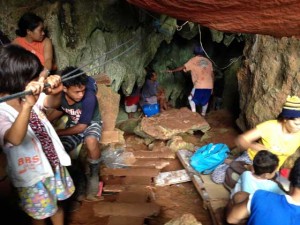But typhoon still a threat to Bicol, Eastern Visayas
Super Typhoon Ruby (Hagupit) lost some power on Friday but remains a serious threat to Bicol and Eastern Visayas, state weathermen said.
Philippine Atmospheric Geophysical Astronomical Services Administration (Pagasa) weather forecaster Chris Perez said cold air from the northeastern monsoon mixed with the warm air that was powering Ruby, weakening it somewhat.
The typhoon was packing 215 kilometer-per-hour winds as it entered the Philippine Area of Responsibility on Thursday. Weathermen said the winds were down to 195 kph but still gusting to 230 kph.
Thousands of people sought shelter in churches, schools and other makeshift evacuation centers on Friday as the typhoon approached.
The storm, which would be the strongest to hit the country this year, is forecast to impact eastern provinces devastated by Super Typhoon Yolanda last year.
People across the country were heeding government warnings to make early preparations.
Perez said Ruby was tracked at 500 km east of Borongan, Eastern Samar, on Friday morning, moving in a west-northwest direction at 13 kph.
The typhoon is expected to make landfall in Eastern Samar between 8 p.m. and 12 noon on Saturday.
Storm warning signals were raised in 34 areas.
Signal number 2 (winds of 61-100 kph expected in at least 24 hours) was up over Sorsogon, Ticao Island, Masbate, Northern Samar, Eastern Samar, Samar, Biliran, Leyte, Southern Leyte, Northern Cebu including Cebu City, Bantayan Island and Camotes Island.
Signal number 1 (winds of 30-60 kph expected in at least 36 hours) was raised over Catanduanes, Albay, Camarines Norte, Camarines Sur, Burias Island and Romblon, Capiz, Iloilo, Antique, Aklan, Negros Oriental, Negros Occidental, the rest of Cebu, Siquijor, Bohol, Surigao del Sur, Agusan del Norte, Surigao del Norte, Dinagat Island, Siargao Island, Misamis Oriental, Agusan del Sur and Camiguin Island.
The National Disaster Risk Reduction Management Council (NDRRMC) chief, Alexander Pama, said on Friday the stockpiling and prepositioning of foods, medicines and disaster management and rescue teams and other necessities were on schedule.
“We have learned our lessons from Yolanda. It’s better to be overprepared than to be underprepared,” Pama said.
Ruby will dump an estimated 7.5-20 mm per hour of rain, categorized as heavy to intense, within its 700-km diameter radius.
Ferries were not allowed to leave port, stranding as many as 2,500 passengers.
Eighteen flights on the Manila, Butuan Cebu and Surigao routes were cancelled.
The Land Transportation Franchising and Regulatory Board (LTFRB) on Friday suspended the operations of all provincial bus companies with roll-on-roll-off (RORO) routes to Southern Luzon, Eastern Visayas and Mindanao.
In Tacloban City, where many buildings still lie in rubble after being destroyed in Yolanda, hundreds of people sheltered in a sports stadium on Friday.
“We’ve learned our lesson from Yolanda (Haiyan),” Rita Villadolid, 39, told AFP as she sat inside the stadium with her family. “Everyone here is gripped with fear.”
Elsewhere in Tacloban, hundreds of people sheltered in churches and schools, some of the sturdiest buildings in the city while wealthier residents checked into hotels.
Similar preparations were occurring across the country.
There was also confusion as to where the eye of the typhoon would pass, with Pagasa and various foreign government typhoon monitoring agencies projecting different paths.
Pagasa predicted the worst of the typhoon would hit the eastern provinces of Samar and Leyte, which were the most badly damaged during Haiyan, then cut across the central Philippines.
But the US Navy’s Joint Typhoon Warning Center predicted it would travel slightly north of Samar, then cut west and pass directly over Manila, the nation’s capital with a population of more than 12 million people.
The US agency on Friday downgraded Ruby from the maximum super typhoon category to typhoon status.
Still, this would make the Hagupit the strongest typhoon to hit the Philippines this year.


